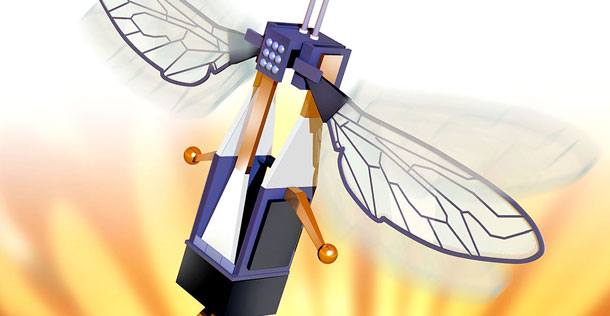Robobees to the Rescue
In late 2006, commercial beekeepers across the country began reporting that an unprecedented number of their honeybee colonies were dying. By 2009, Popular Science magazine estimated the culprit, a mysterious affliction that became known as colony collapse disorder (CCD), had wiped out 36 percent of the 2.4 million hives in the United States.
The phenomenon is alarming. Through their pollination of spring and summer crops, honeybees are responsible for one-third of the nation’s food supply. As researchers have urgently sought to discover the cause and cure for CCD, a group of Harvard University scientists joined together a year ago to find out whether they might offer an alternative answer to the crisis. One of those experts, Greg Morrisett, discussed their innovative approach at this year’s Hollins Science Seminar, held March 31.
“An electrical engineer who works down the hall from me had seen a PBS program on how the bees were disappearing and no one knew why,” recalls Morrisett, Harvard’s Allen B. Cutting Professor of Computer Science and the brother of Julie Clark, associate professor of mathematics at Hollins. “He and an expert in microrobotics and I started talking with a couple of biologists to learn more about colony collapse disorder, and we said, ‘Well, here’s a crazy idea. Let’s put a proposal together where we’ll build a swarm of artificial bees to go pollinate crops in case all the bees die off.’”
At the same time, the National Science Foundation (NSF) was seeking “to inspire people in universities to come together from different disciplines to do something big and outrageous and very risky,” says Morrisett. The NSF established a five-year, $10 million program for a team of biologists, computer scientists, and mechanical and electrical engineers at Harvard to develop robotic bees to potentially augment the pollinating function of the bees that have been affected by CCD.
Now that the first year of the project is complete, Morrisett is delighted with the progress the team has made with their robobee, which is built out of carbon fiber and titanium, weighs about 500 milligrams, and is no bigger than a finger tip. “This is the first microrobotic insect that has the appropriate motor and wings to generate enough lift to actually fly.” He adds that the team is excited about other uses for robotic insects in addition to crop pollination, including search-and-rescue after a disaster and environmental exploration in dangerous locations such as volcanoes.
But Morrisett and his team must overcome a number of formidable obstacles before their robobee reaches practical application. “Probably the hardest problem we face right now is how you power it,” he says. “Even the smallest version possible of the lithium polymer batteries used in cell phones and laptops is too heavy to allow the robobee to get off the ground and stay in the air for long. We’ve found that silicon oxide fuel cells are a very lightweight yet powerful alternative, but they run hot—about 700 degrees Celsius—and that would melt the chassis. So our challenge is developing a fuel cell that will run at room temperature.”
Another problem the team must solve is how to incorporate a “brain” into the robot that can provide for movement and navigation and recognize objects. Their hope is that a mechanism called an optical flow sensor will provide a light, inexpensive, and energy-efficient alternative to heavy cameras and computers that require a lot of power.
The dilemma in which Morrisett is most interested lies in the management of the collective swarm. “If I have a colony of 10,000 of these robots, how do I program them? Can I set up communication networks between them, and how do I do that in a way that’s still viable if one of the bees runs out of power? Can you do this in such a way where there is no centralized command and control? There are a lot of big questions here related to computer science.”
Morrisett is not discouraged that researchers are “many years away,” perhaps as long as two decades, from making robobees viable. “There are going to be so many other successes in individual domains such as mechanical manufacturing,” he explains. “And we have a lot of students working with the different problems in this project, and what will come out of that is young people who are engaged with emerging technologies and excited about crossing the traditional science and engineering boundaries. Hopefully in twenty years we’ll have a whole new cadre of trained scientists and engineers who are doing amazing things. The NSF is going to get their money’s worth out of this research.”
He is also optimistic the recent finding that a viral/fungal combination may be the cause of CCD will result in a remedy for the syndrome. Even though robotics may play a significant role in complementing the essential work that honeybees perform, Morrisett insists that “a natural solution is the preferred one.”


